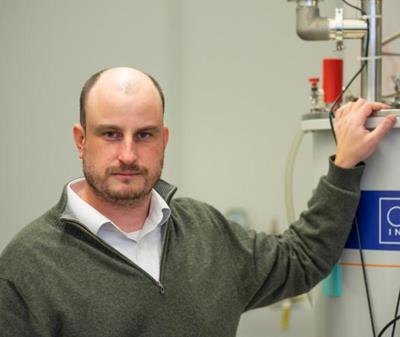 The Physics and Astronomy Department has welcomed Bill Gannon as assistant professor of Physics and Astronomy in the fall of 2019 after postdoctoral fellowships at Stony Brook University and Brookhaven National Laboratory, Texas A&M University and the University of British Columbia.
The Physics and Astronomy Department has welcomed Bill Gannon as assistant professor of Physics and Astronomy in the fall of 2019 after postdoctoral fellowships at Stony Brook University and Brookhaven National Laboratory, Texas A&M University and the University of British Columbia.
Gannon received his B.S. degree in physics from the University of Michigan and his Ph.D. from Northwestern University. He is originally from Alexandria, Virginia, just across the Potomac River from Washington, D.C.
Gannon’s primary research interests are in the synthesis of materials with interesting quantum magnetic properties, which he studies using neutron scattering. Interactions among electrons in a material can lead to a variety of magnetic properties that cannot be understood by considering each individual electron on its own. Of particular interest to Gannon are those whose magnetic properties are dominated by “excitations,” i.e., dynamic rather than static magnetic phenomena.
The quantum entangled nature of the excitations in some of these materials has made them of great interest to the quantum information community. Much of the knowledge about these materials, however, comes from electrically insulating compounds. Gannon’s research explores the physics of low-dimensional spin chains and spin liquids in metals, which would be of great importance to their use in future commercial devices.
One example of recent work in this area is described in a paper that Gannon published in the Journal Nature Communications (https://www.nature.com/articles/s41467-019-08715-y). These experiments used inelastic neutron scattering to probe dynamical magnetism. The experiment takes a sample to a neutron source, such as the Spallation Neutron Source at Oak Ridge National Laboratory in Oak Ridge, Tennessee, and bombards the sample with neutrons. Neutrons have the quantum magnetic property of spin and can therefore interact with magnetic materials. By observing the properties of scattered neutrons, Gannon and colleagues can reconstruct the magnetic properties in the material.
The study was on the material Yb2Pt2Pb, where the rare earth Yb magnetic ions in the sample are arranged in one-dimensional chains. If there is no magnetic field, the magnetic excitations are purely one dimensional and remain dynamical to temperatures near absolute zero (i.e. there is no static magnetic order), an extremely unusual phenomenon. When a modest external magnetic field is turned on, the magnetic excitations become three dimensional but, interestingly, remain dynamic. This change in dimensionality of the excitations is an example of confinement, which can be seen in a wide range of physical systems, most famously the Higgs Boson.
Gannon’s research at UK will continue studying these effects in other metals that host strong magnetic fluctuations while also branching out in new directions, making use of the characterization facilities in our Center for Advanced Materials. His lab in the Chemistry-Physics building also includes facilities for crystal growth and measurements of transport and magnetic properties as functions of temperature, reaching milli-Kelvin temperatures. With a team that includes a postdoc and graduate students, Gannon has been successful in synthesizing a material that is predicted to have interesting topological properties, as well as being a metal with magnetic moments on a “Kagome lattice” of corner sharing triangles. That work has been able to continue during Covid-19, and the group is beginning detailed measurements of these materials. In the near future, they hope to take advantage of UK’s proximity to Oak Ridge to perform neutron scattering experiments.
